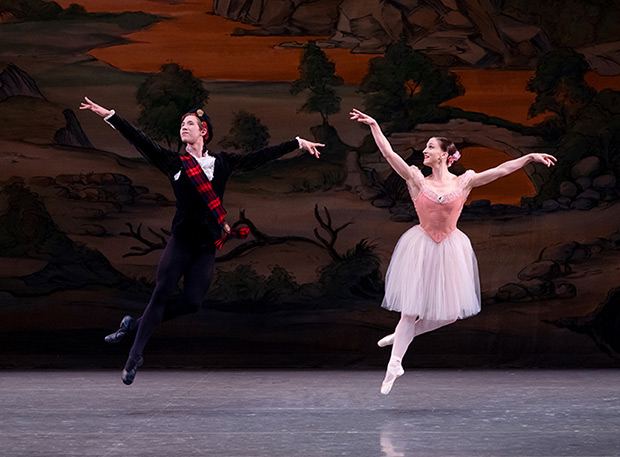
© Paul Kolnik. (Click image for larger version)
New York City Ballet
All Balanchine: Scotch Symphony, Valse Fantaisie, Sonatine, Stravinsky Violin Concerto
★★★★✰
New York, David H. Koch Theater
8 May 2019
www.nycballet.com
davidhkochtheater.com
Highland Dance
There’s a reason why New York City Ballet doesn’t do George Balanchine’s Scotch Symphony very often. It’s a strangely disjointed ballet in which the two outer movements seem to have nothing to do with the middle one. The soloist woman who leads the opening section, set to the jaunty second movement of Mendelssohn’s Scottish Symphony, leaves and never returns. In my head, I think of this cheerful opening as the “Welcome to Scotland!” section, because of its fast, happy, trilling footwork and shoulder-heavy walking steps. After that comes the rather darker second movement, a pas de deux for a sylph-like figure in pale pink and a kilted and beret-wearing young man. It keeps getting interrupted; she bourrées off and returns accompanied by more men in kilts whose function seems to be to make sure the lovers never get togther. (Insert obvious and obligatory La Sylphide subtext.) Finally, in the third section, Balanchine dispenses with any illusion of coherence and brings back the ensemble – except for the “highland girl” – and gets down to some serious, completely abstract, dancing, including a series of virtuosic entrées for the leads. There is a lovely section where the corps creates a kind of structure around the two of them with their arms, then peels away in twos, choreography as architectures.
Incoherent, perhaps, but wonderful all the same. First of all, Mendelssohn’s music, begun after a trip to Scotland 1829, is a delight, with strong echoes of the music he composed for Midsummer Night’s Dream not long before. With typical fluency, Mendelssohn weaves a series of Scottish melodies into the orchestrations, where they unspool endlessly. The opening clarinet melody warbles like a brook in spring; bringing happiness with every reprise.
The choreography, at least in the outer movements, has a similar ebullience. Not long ago Patricia Wilde, the dancer who created the “highland girl” role in 1952, told me that Balanchine had made the ballet after an NYCB tour that stopped in Edinburgh, where the company went to see Highland dancers, accompanied by bagpipers. He loved their light-footed style, she said, the way their heels never touched the ground. And he asked his dancers to do the same. “He wanted us to go down into a grand plié,” she told me, “and then up into the air into an entrechat six, all without ever putting our heels down.”
The City Ballet orchestra, which has been sounding a bit out of sorts lately – never enough rehearsal time – pulled itself together and gave a respectable account of the score. Alston Macgill, as the “welcome to Scotland” dancer, moved lightly on her demi-pointes and danced with speed and clarity, though her jumps could have used a bit more air.
The sylph-human pair was made up of Sterling Hyltin and Anthony Huxley – both, like Macgill, débuting. I ascribe the pas de deux’s lack of fatefulness to several factors. First: the Koch stage is undoubtedly too big for Scotch Symphony, originally created for the smaller stage at City Center. The dancers have to create a sense of mystery and intimacy while covering a vast empty expanse. But on this occasion the dancers, too, contributed to the lack of dramatic heft; Hyltin’s quick, delicate dancing felt too lightweight. Huxley, as buoyant and elegant as one could ever desire, has a bland stage presence. He was more boyish than yearning. As the sylph bourréed out of his grasp, or blocked his approach with her outstretched leg in arabesque, there was little sense of love thwarted. Later, Huxley received a well-deserved applause for a virtuosic solo in which, among other things, he does multiple pirouettes ending in arabesque, while facing in different directions.
The centerpiece of the evening consisted of two short works, Valse Fantaisie and Sonatine, that premiered within six years of each other, in 1969 and 1975. Valse is a wild ride, a breathless showcase of momentum and stamina. The leads, Indiana Woodward and Harrison Ball, were both débuting, and gave authoritative, exciting accounts of the ballet’s piquant, space-devouring steps; at times they seemed literally to be flying. Woodward was a delight, down to the way the costume – a lilac bodice over a lilac tulle tutu – fitted her. With her cinched waist and rounded shoulders, she was the picture of a nineteenth-century ballerina. But there was nothing vintage about her dancing. Pinprick piqués, sharp and quick pas de chats, soaring jetés – she polished them off, with energy and charm to spare. Ball, too, danced with bravura and ease. I’ve admired Woodward for a long time, but Valse Fantaisie is made for her.
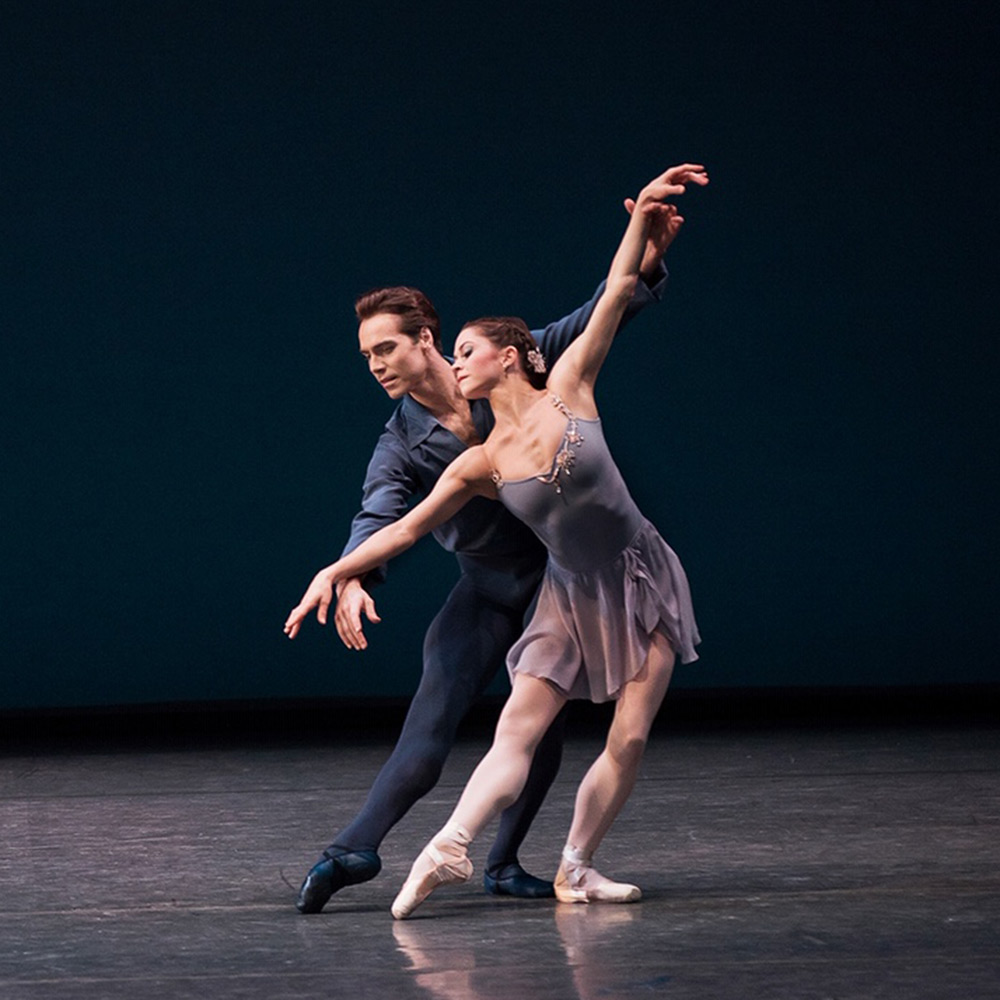
© Paul Kolnik. (Click image for larger version)
Sonatine, made for Violette Verdy, is a pas de deux about freedom, specifically, the freedom of the female dancer. In a coaching of the ballet several years ago, she told a dancer: “it’s like a walk in the park, or like a game…do you want more?” The quickly-paced third movement, an impressionist flurry of notes for the piano, brings out the her playful, coquettish side. (The pianist was Elaine Chelton, a little dry for my taste, but impeccable.) With the woman’s first step onstage, she sets the music in motion. Then she dances a little soliloquy, a cousin of the Verdy solo in Emeralds: foot-drags that show off the shape of the leg, a game of hopscotch, taps in every direction. What sets these roles apart is that the dancer seems to do dance for her own pleasure, well aware that she is also seducing the observer.
Megan Fairchild, in fine form after returning from maternity leave, was the soloist. Fairchield doesn’t give off the whiff of mystique some other ballerinas use to their advantage in this role, but her dancing is playful and smart and uninhibited, qualities that get you almost all the way there. In the first movement, she really showed the hip-forward moves that are such an important element of the ballet’s charm. Taylor Stanley, a dancer not given to extroverted displays, imbues his role with a note of mystery. He emphasizes the choreography’s eccentricities, the deep turned-in crouches and folk steps, and, in particular, the partnering, which happens mostly with hooked elbows or overlapping wrists. In Sonatine, the man assists, but never leads. In fact, the only leading here is done by the woman, at the end of the opening movement: as she pulls the man offstage, she faces forward, he backward. She faces the future face on – he walks blindly into the unknown.

© Paul Kolnik. (Click image for larger version)
Every season there is a ballet that seems to fire the company’s imagination like no other, and this season it is Stravinsky Violin Concerto. I’ve seen three casts so far. This one, led by Sara Mearns, Lauren Lovette, Aaron Sanz, and Joseph Gordon (Sanz and Gordon were débuting) was as vibrantly danced as the others. It’s a ballet full of contradictions: energetic, combative, at times melancholy, but also playful and even zany. For example, in the final movement, where the dancers shuffle around with their arms crossed, or mark time by raising and lowering their thumbs. The Toccata, danced by squads of five dancers, is like an Olympic competition, full of swashbuckling moves and kicks and chassés and jumps criss-crossing the stage. Who will win it this time? The two pas de deux are, again a study in contrasts, the first aggressive, the second tender, almost needy. Lovette’s dancing in the latter had seemed motivated by an internal story. As she kneeled and reached for Gordon, you could almost hear her calling out to him. When he lunged for her, she waited, standing on point, until he touched her legs, then bent her knees in surrender.
It is a great ballet to end with, particularly when it is as well danced as it is this season. The audience goes out on a high. Scotch Symphony may not have the same galvanizing effect, but it’s good to see it again. Even when it feels a little lost in the mists, as it currently does.












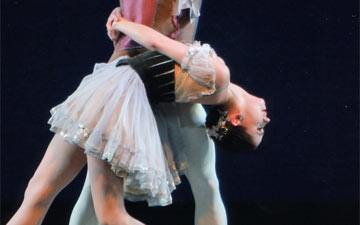


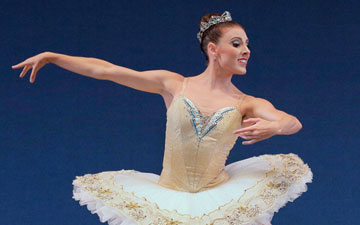
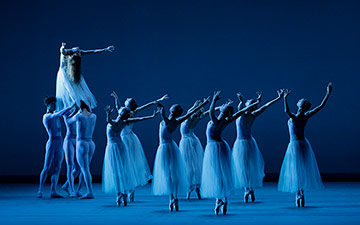
You must be logged in to post a comment.